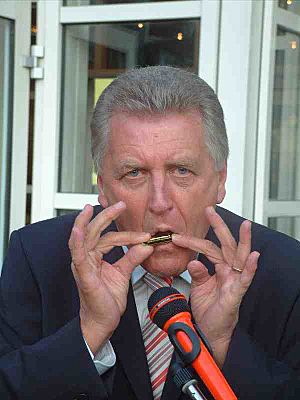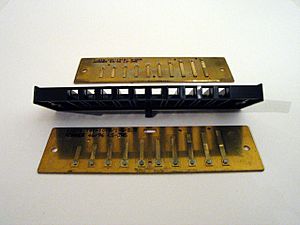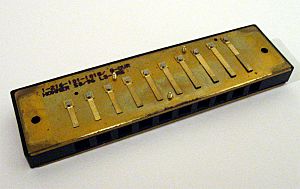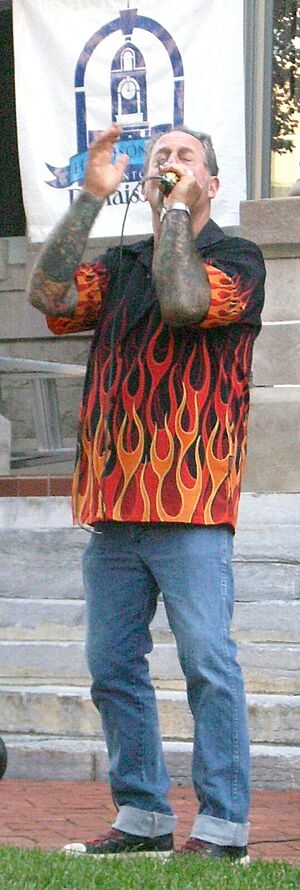Harmonica facts for kids
A harmonica is a small musical instrument you play with your mouth. You make sounds by blowing or sucking air into holes on its side. Harmonicas are often cheap and easy to learn. They make music from tiny metal strips called reeds that vibrate inside the harmonica's case.
Harmonicas are popular in many types of music, like blues, folk, rock and roll, and pop music. There's also a special kind called a chromatic harmonica, which is used in jazz and classical music. Harmonicas come in different musical keys, like C, G, and A, which means they can play different sets of notes.
Contents
Parts of a Harmonica
A harmonica has three main parts: the comb, the reed-plates, and the cover-plates.
The Comb
The comb is the main body of the harmonica. It has air chambers that cover the reeds. It's called a "comb" because early harmonicas looked a bit like a hair comb. Long ago, combs were made of wood. Today, they are usually made from plastic or metal.
The material of the comb doesn't change the sound much. What's more important is how strong it is. Wooden combs can soak up moisture from your breath, which can make them swell and feel uncomfortable. Modern wooden combs are better, but some players still dip harmonicas in water to change their sound or make it easier to bend notes.
Reed-Plates
A reed-plate holds several reeds together. Reeds are usually made of brass, but sometimes steel, aluminum, or plastic are used. These small metal strips are attached to the reed-plate. When you blow, reeds on the inside vibrate. When you suck air, reeds on the outside vibrate.
Most harmonicas have reed-plates screwed onto the comb. This is helpful because reeds can go out of tune over time, and you can replace the plates. Some older or simpler harmonicas might have reed-plates nailed or glued on.
Cover Plates
Cover plates go over the reed-plates. They are usually made of metal, but can also be wood or plastic. These plates help project the sound, so they affect how the harmonica sounds. There are open designs and enclosed designs. Enclosed designs often make the sound louder. Some modern designs have special covers that allow for unique playing styles.
Windsavers
Windsavers are thin strips of plastic or other material glued onto the reed-plate. They act like one-way valves. They are mostly found in chromatic harmonicas. When you play a note, the windsaver on the other reed slot closes. This stops air from leaking out and helps the harmonica play more clearly.
Mouthpiece
The mouthpiece is where you put your mouth. It connects your mouth to the air chambers inside the harmonica. On many harmonicas, the mouthpiece is part of the comb or cover. On chromatic harmonicas, it's often a separate piece with a groove for the slide. The mouthpiece helps make playing comfortable and is key for how chromatic harmonicas work.
Harmonica Accessories
Harmonica players sometimes use extra gear to make their music even better.
Amplification Devices
Since the 1950s, many blues harmonica players have used microphones and tube amplifiers to make their harmonicas louder. A famous player named Little Walter used a "Bullet" microphone. This made his harmonica sound strong and punchy, so it could be heard over electric guitars. Tube amplifiers also add a cool, natural distortion to the sound, making it fuller. Little Walter also cupped his hands around the harmonica, which made the sound even more powerful and distorted, almost like a saxophone. People sometimes call the harmonica a "Mississippi saxophone" because of this.
Rack or Holder
If a harmonica player wants to play another instrument, like an acoustic guitar, at the same time, they use a "neck rack" or holder. This device holds the harmonica in front of their mouth. It clamps the harmonica between two metal brackets, which are attached to a curved metal loop that rests on the shoulders. Many folk musicians and singer/songwriters, like Bob Dylan and Neil Young, use these holders.
Types of Harmonicas
There are several different kinds of harmonicas, each with its own special features.
Chromatic Harmonica
The chromatic harmonica has a button on the side. When you press this button, it moves a sliding bar. This bar redirects air to different reeds, allowing you to play all the notes of the musical scale, including sharps and flats. This means you can play in any key with just one harmonica. Chromatic harmonicas are used in many styles, including classical, jazz, and blues.
Diatonic Harmonicas
"Diatonic" means a harmonica is designed to play in just one key. However, skilled players can make them play notes outside that key. Depending on where you are in the world, "diatonic harmonica" might mean a tremolo harmonica or a blues harp. Other diatonic harmonicas include the octave harmonica.
Tremolo Harmonica
The tremolo harmonica has a unique sound. For each note, it has two reeds. One reed is tuned slightly sharp, and the other is slightly flat. When both vibrate, they create a special wavering or "warbling" sound. This type of harmonica is very popular in East Asian music, from rock to pop.
Orchestral Harmonicas
These harmonicas are made for playing in groups or orchestras.
Orchestral Melody Harmonica
One common type is the Horn harmonica, often found in East Asia. These have a single large comb with reeds that only play when you blow. They are set up like a piano keyboard, with natural notes on the bottom and sharps/flats on the top. They can cover two or three octaves and are used in East Asian harmonica orchestras. They often sound like a brass section because of their larger reeds and special "horn" covers.
Another type is the Polyphonia. These have all twelve chromatic notes in one row. Most Polyphonias have both blow and draw notes for the same tone.
Chord Harmonica
The chord harmonica can play many different chords, up to 48! These include major, seventh, minor, augmented, and diminished chords. It's designed for playing in ensembles. Each hole usually has two reeds for each note, tuned an octave apart. Some orchestra harmonicas can even play both bass notes and chords.
How Harmonicas Are Played

To play a harmonica, you simply blow or suck air into one of its many holes. Each hole is designed to play a different note when you blow or suck. By moving your mouth across the holes and changing how you breathe, you can create melodies and chords.
Famous Harmonica Players
Many musicians are known for playing the harmonica:
- Bob Dylan is a famous harmonica player from the 1960s folk rock scene.
- Willi Burger is a famous classical harmonica player.
- Neil Young is a folk/grunge musician who plays the harmonica.
- Steven Tyler, from Aerosmith, plays the harmonica.
- Little Walter was one of the most well-known blues harmonica players ever.
- Yvonnick Prene is a groundbreaking jazz harmonica player.
Other Names for Harmonica
The harmonica has many different nicknames, such as: mouth organ, mouth harp, Hobo Harp, French harp, Reckless Tram, harpoon, tin sandwich, blues harp, Mississippi saxophone, or simply harp.
Images for kids
See also
 In Spanish: Armónica para niños
In Spanish: Armónica para niños










